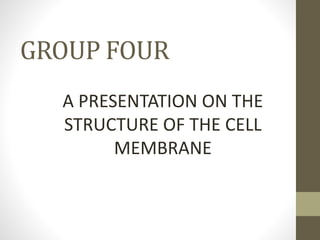
THE STRUCTURE OF THE CELL MEMBRANE.pptx
- 1. GROUP FOUR A PRESENTATION ON THE STRUCTURE OF THE CELL MEMBRANE
- 2. THE STRUCTURE OF THE CELL MEMBRANE
- 3. THE CELL MEMBRANE • The cell membrane is a structure that separates the interior of a cell from its outside environment. • The cell membrane regulates what enters and exits the cell so that it does not lose too many nutrients or take in too many ions. • It is selectively permeable in function.
- 4. STRUCTURE OF THE CELL MEMBRANE • The fluid mosaic model of the cell membrane is how scientists describe what the membrane looks like and functions. • It was first proposed in 1972. • According to this model, the membrane is a fluid structure with a mosaic of components – primarily, proteins and cholesterol embedded in or attached to a double layer (bilayer) phospholipid. • The pattern of these molecules put together is known as mosaic. • The molecules are constantly moving in two dimensions, a fluid fashion, similar to icebergs floating in the ocean. • The movement of the mosaic of molecules makes it impossible to form a completely impenetrable barrier.
- 6. PHOSPHOLIPDS • The cell membrane is made up of a phospholipid bilayer. • Phospholipids are lipids (fatty acid chains) with a phosphate group attached to them. • The phospholipids have one head and two tails. • The head is polar and hydrophilic, or water-loving. • The tails are nonpolar and hydrophobic, or water-fearing.
- 7. • The cell membrane is exposed to water mixed with electrolytes and other materials on the outside and the inside of the cell. • The phosphate heads in each phosphate layer face the aqueous or watery environment on either side and the tails face away from the water between the layers of the head, because they are hydrophobic. • This arrangement means that only small, uncharged molecules can pass through the membrane. • The membrane is called semi-permeable, meaning that some things can pass through without assistance, while other things cannot.
- 8. CHOLESTEROL • Cholesterol is a type of steroid. • The cholesterol molecules are randomly distributed across the phospholipid bilayer, helping the bilayer stay fluid in different environmental conditions. • The cholesterol holds the phospholipid together so that they do not separate too far, letting unwanted substances in, or compact tightly, restricting movement across the membrane.
- 9. • Without cholesterol, the phospholipids in your cell membrane will start to get closer when exposed to cold making it difficult for small molecules like gases to squeeze in between the phospholipids like they normally do. • Without cholesterol, the phospholipids start to separate from each other leaving large gaps.
- 10. PROTEINS • The cell membrane is made up of two different types of proteins: integral and peripheral proteins. • Integral proteins are embedded into the phospholipid bilayer; may or may not extend through both layers. • They are helpful for transporting large molecules like glucose across the cell membrane. • Peripheral proteins are found on the inner or outer surface of the phospholipid bilayer, but not embedded in the hydrophobic core. They can be attracted to the ends of the integral proteins, or not, and help in transport or communication between neighbouring cells.
- 11. WHAT CAN GO THROUGH THE CELL MEMBRANE • The fluid mosaic model helps and explains how membranes regulate the movement of substances in and out of the cell. • Substances do not move across the barrier indiscriminately; membranes are selectively permeable. • The cell is able to take up many varieties of small molecules and ions and exclude others. • Substances that move through the cell membrane do so at different rates.
- 12. • Movement of a molecule through a membrane depends on the interaction of the molecule with the hydrophobic core of the membrane. • Nonpolar molecules, such as hydrocarbons, CO2 and O2 are hydrophobic and can dissolve in the lipid bilayer and cross easily, without the resistance of membrane proteins. • The hydrophobic core impedes the direct passage of ions and polar molecules, which are hydrophilic. • Proteins assist and regulate the transport of ions and polar molecules. • These ions and polar molecules pass through transport proteins that span the membrane, avoiding contact with the lipid bilayer. • Each transport protein is specific for the substance that it translocates. • Some transport proteins called channel proteins have a hydrophilic channel that certain molecules and ions can use as a tunnel through the membrane. • The passage of water through the membrane can be greatly facilitated by channel proteins known as aquaporins.
- 13. Channelproteins
- 14. THANK YOU.